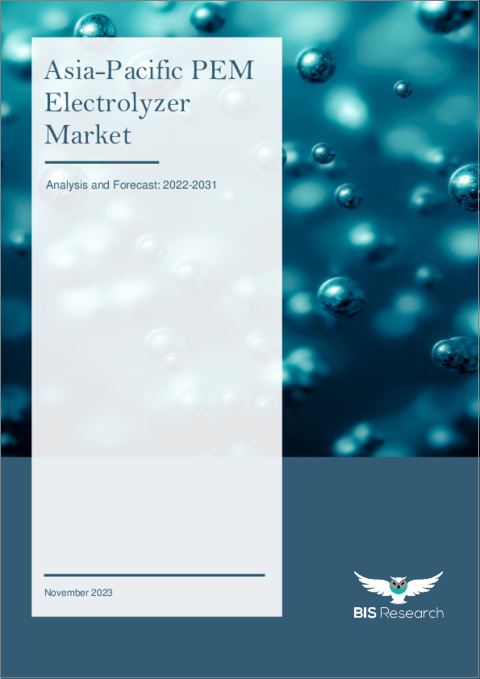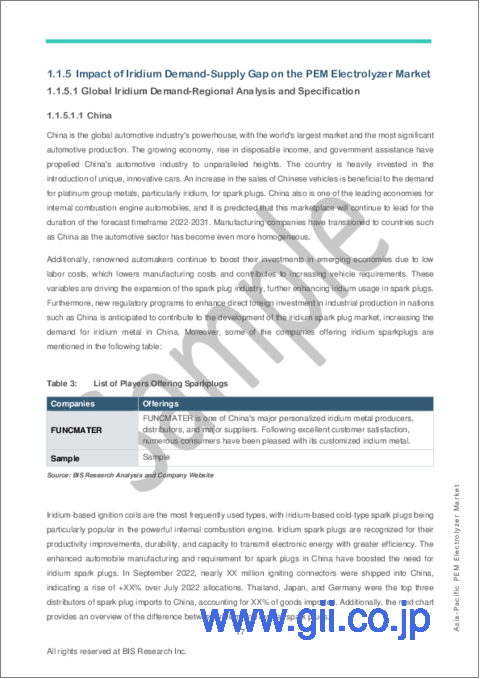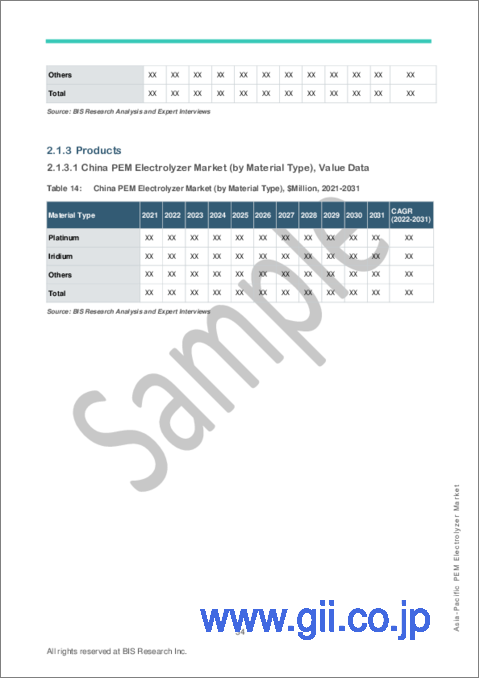|
|
市場調査レポート
商品コード
1379163
アジア太平洋地域のPEM電解槽市場:2022-2031年Asia-Pacific PEM Electrolyzer Market - Analysis and Forecast, 2022-2031 |
||||||
カスタマイズ可能
|
|||||||
| アジア太平洋地域のPEM電解槽市場:2022-2031年 |
|
出版日: 2023年11月10日
発行: BIS Research
ページ情報: 英文 96 Pages
納期: 1~5営業日
|
- 全表示
- 概要
- 図表
- 目次
中国を除くアジア太平洋地域のPEM電解槽の市場規模は、2022年の1,470万米ドルから、予測期間中は40.1%のCAGRで推移し、2031年には3億670万米ドルの規模に成長すると予測されています。
PEM電解槽の需要は、メタノール製造、輸送、電力・エネルギー貯蔵、アンモニア製造、精製など、さまざまなエンドユーザー産業からの需要の増加によりアジア太平洋地域で急増すると予想されています。公共部門および商業部門における再生可能エネルギー源への大規模な投資に支えられ、グリーン水素製造のためのPEM電解槽の使用が大幅に増加する見通しです。しかし一方で、近い将来、貯蔵施設や輸送施設などの水素関連インフラの不足が地域の市場成長を抑制する可能性があります。
当レポートでは、アジア太平洋地域のPEM電解槽の市場を調査し、市場概要、市場成長への各種影響因子の分析、法規制環境、市場規模の推移・予測、各種区分・地域/主要国別の詳細分析、競合情勢、主要企業の分析などをまとめています。
| 主要市場統計 | |
|---|---|
| 予測期間 | 2022-2031年 |
| 2022年評価 | 1,470万米ドル |
| 2031年予測 | 3億670万米ドル |
| CAGR | 40.1% |
市場区分:
セグメンテーション1:エンドユーザー別
- 精製産業
- 電力・エネルギー貯蔵
- アンモニア製造
- メタノール製造
- 輸送
- その他
セグメンテーション2:材料タイプ別
- イリジウム
- プラチナ
- その他
セグメンテーション3:国別
- 日本
- インド
- 韓国
- オーストラリア
- その他のアジア太平洋地域
目次
第1章 市場
- 業界の展望
- 動向:現在と未来
- サプライチェーン分析
- エコシステム/進行中のプログラム
- COVID-19がPEM電解槽市場に与える影響
- イリジウムの需給ギャップがPEM電解槽市場に与える影響
- アジア太平洋のイリジウム需要分析:地域別
- PEM電解槽に対するイリジウムの影響:現在と将来
- イリジウムの需給ギャップ
- PEM電解槽市場シナリオ
第2章 地域
- 中国
- 市場
- 用途
- 製品
- アジア太平洋および日本
- 市場
- 用途
- 製品
- アジア太平洋および日本(国別)
第3章 市場:競合ベンチマーキング・企業プロファイル
- 競合ベンチマーキング
- 競合マトリックス
- 主要企業の製品マトリックス
- 主要企業の市場シェア分析
- 企業プロファイル
- Elchemtech Co., Ltd.
- Hitachi Zosen Corporation
- Beijing SinoHy Energy Co., Ltd
- Ningbo VET Energy Technology Co., Ltd.
第4章 調査手法
List of Figures
- Figure 1: PEM Electrolyzer Market, $Million, 2021, 2022, and 2031
- Figure 2: PEM Electrolyzer Market (by End User), $Million, 2021 and 2031
- Figure 3: PEM Electrolyzer Market (by Material Type), $Million, 2021 and 2031
- Figure 4: PEM Electrolyzer Market (by Region), $Million, 2021 and 2031
- Figure 5: Technological Possibilities for Green Hydrogen Production Under $1.5/kg by 2050
- Figure 6: Anticipated Capacity for Producing Electrolyzers (by region), 2021-2031
- Figure 7: Supply Chain Analysis of the Global PEM Electrolyzer Market
- Figure 8: Comparison Chart of Iridium Spark Plugs and Regular Spark Plugs
- Figure 9: Iridium Market Supply and Demand, Tons, 2021-2031
- Figure 10: PEM Electrolyzer Market Volume based on Historical, Optimistic, and Realistic Scenario, MW, 2021-2031
- Figure 11: Research Methodology
- Figure 12: Top-Down and Bottom-Up Approach
- Figure 13: PEM Electrolyzer Market Influencing Factors
- Figure 14: Assumptions and Limitations
List of Tables
- Table 1: List of Green Hydrogen Programs by Major Countries
- Table 2: Comparison Table of Various Fuel Sources
- Table 3: List of Players Offering Sparkplugs
- Table 4: Iridium Usage by Country
- Table 5: India and Japan Import Data
- Table 6: Asia-Pacific Iridium Demand Analysis (by Region), Tons, 2021 to 2031
- Table 7: Asia-Pacific Iridium Demand Analysis (by Region), $Million, 2021 to 2031
- Table 8: Characteristics of Alkaline and PEM Electrolyzers
- Table 9: Iridium, Osmium, and Ruthenium: Import Analysis by Key Countries, $Thousand, 2017-2021
- Table 10: Iridium, Osmium, and Ruthenium: Export Analysis by Key Countries, $Thousand, 2017-2021
- Table 11: PEM Electrolyzer Market Volume based on Historical, Optimistic, and Realistic Scenario, MW, 2021-2031
- Table 12: China PEM Electrolyzer Market (by End User), MW, 2021-2031
- Table 13: China PEM Electrolyzer Market (by End User), $Million, 2021-2031
- Table 14: China PEM Electrolyzer Market (by Material Type), $Million, 2021-2031
- Table 15: Asia-Pacific and Japan PEM Electrolyzer Market (by End User), MW, 2021-2031
- Table 16: Asia-Pacific and Japan PEM Electrolyzer Market (by End User), $Million, 2021-2031
- Table 17: Asia-Pacific and Japan PEM Electrolyzer Market (by Material Type), $Million, 2021-2031
- Table 18: Japan PEM Electrolyzer Market (by End User), MW, 2021-2031
- Table 19: Japan PEM Electrolyzer Market (by End User), $Million, 2021-2031
- Table 20: Japan PEM Electrolyzer Market (by Material Type), $Million, 2021-2031
- Table 21: South Korea PEM Electrolyzer Market (by End User), MW, 2021-2031
- Table 22: South Korea PEM Electrolyzer Market (by End User), $Million, 2021-2031
- Table 23: South Korea PEM Electrolyzer Market (by Material Type), $Million, 2021-2031
- Table 24: India PEM Electrolyzer Market (by End User), MW, 2021-2031
- Table 25: India PEM Electrolyzer Market (by End User), $Million, 2021-2031
- Table 26: India PEM Electrolyzer Market (by Material Type), $Million, 2021-2031
- Table 27: Australia PEM Electrolyzer Market (by End User), MW, 2021-2031
- Table 28: Australia PEM Electrolyzer Market (by End User), $Million, 2021-2031
- Table 29: Australia PEM Electrolyzer Market (by Material Type), $Million, 2021-2031
- Table 30: Rest-of-Asia-Pacific PEM Electrolyzer Market (by End User), MW, 2021-2031
- Table 31: Rest-of-Asia-Pacific PEM Electrolyzer Market (by End User), $Million, 2021-2031
- Table 32: Rest-of-Asia-Pacific PEM Electrolyzer Market (by Material Type), $Million, 2021-2031
- Table 33: Product Matrix for Key Companies
- Table 34: Market Share of Key Companies
“The Asia-Pacific PEM Electrolyzer Market (excluding China) Expected to Reach $306.7 Million by 2031.”
| KEY MARKET STATISTICS | |
|---|---|
| Forecast Period | 2022 - 2031 |
| 2022 Evaluation | $14.7 Million |
| 2031 Forecast | $306.7 Million |
| CAGR | 40.1% |
Introduction to Asia-Pacific (APAC) PEM Electrolyzer Market
The Asia-Pacific PEM electrolyzer market (excluding China) is projected to reach $306.7 million by 2031 from $14.7 million in 2022, growing at a CAGR of 40.1% during the forecast period 2022-2031. PEM electrolyzer demand is expected to soar in the Asia-Pacific (APAC) area due to growing demands from a variety of end-use industries, such as methanol manufacturing, transportation, power and energy storage, ammonia production, and refining. A significant increase in the use of PEM electrolyzers for the production of green hydrogen is anticipated, supported by significant investments in renewable energy sources from both public and commercial sectors. However, in the near future, the lack of hydrogen-related infrastructure, such as storage and transportation facilities, may hinder the region's PEM electrolyzer market's expansion.
Market Introduction
Proton Exchange Membrane (PEM) electrolyzer sales are currently expanding in the Asia-Pacific (APAC) market due to a number of important factors. The market is expected to develop primarily because to the growing popularity of fuel cell vehicles and the increased focus on decarbonization and lowering greenhouse gas emissions. The need for ecologically friendly fuels is also anticipated to increase due to a spike in demand from a variety of end-user industries and the introduction of stronger government laws targeted at reducing greenhouse gas emissions. The growing need for green hydrogen is expected to propel the growth trajectory of the worldwide PEM electrolyzer market, which is also expected to gain from it. PEM electrolyzers are becoming more and more necessary as a result of fuel cell electric vehicles.
Market Segmentation:
Segmentation 1: by End User
- Refining Industry
- Power and Energy Storage
- Ammonia Production
- Methanol Production
- Transportation
- Others
Segmentation 2: by Material Type
- Iridium
- Platinum
- Others
Segmentation 3: by Country
- Japan
- India
- South Korea
- Australia
- Rest-of-Asia-Pacific
How can this report add value to an organization?
Product/Innovation Strategy: The product segment helps the reader understand the different material types involved in the production of PEM electrolyzers. Moreover, the study provides the reader with a detailed understanding of the Asia-Pacific PEM electrolyzer market based on the end user (refining industry, ammonia production, methanol production, power and energy storage, transportation, and others). PEM electrolyzers are gaining traction in end-user industries on the back of sustainability concerns and their high-power density properties. They are also being used for controlling GHG emissions.
Growth/Marketing Strategy: The APAC PEM electrolyzer market has seen major development by key players operating in the market, such as business expansions, partnerships, collaborations, mergers and acquisitions, and joint ventures. The favored strategy for the companies has been product developments, business expansions, and acquisitions to strengthen their position in the global PEM electrolyzer market.
Competitive Strategy: Key players in the APAC PEM electrolyzer market analyzed and profiled in the study involve PEM electrolyzer manufacturers and the overall ecosystem. Moreover, a detailed competitive benchmarking of the players operating in the Asia-Pacific PEM electrolyzer market has been done to help the reader understand how players stack against each other, presenting a clear market landscape.
Key Market Players and Competition Synopsis
The companies that are profiled have been selected based on inputs gathered from primary experts and analysing company coverage, product portfolio, and market penetration.
Some of the prominent names established in this market are:
|
|
Table of Contents
1 Markets
- 1.1 Industry Outlook
- 1.1.1 Trends: Current and Future
- 1.1.1.1 Rising Government Efforts to Construct Low-Carbon Infrastructure
- 1.1.1.2 Surge in Sustainable Hydrogen Economy
- 1.1.1.3 Rising Demand for Advanced Electrolysis Technologies
- 1.1.2 Supply Chain Analysis
- 1.1.3 Ecosystem/Ongoing Programs
- 1.1.3.1 Consortiums and Associations
- 1.1.3.2 Regulatory Bodies
- 1.1.3.3 Government Programs
- 1.1.3.4 Programs by Research Institutions and Universities
- 1.1.4 Impact of COVID-19 on the PEM Electrolyzer Market
- 1.1.5 Impact of Iridium Demand-Supply Gap on the PEM Electrolyzer Market
- 1.1.5.1 Global Iridium Demand-Regional Analysis and Specification
- 1.1.5.1.1 China
- 1.1.5.1.2 Asia-Pacific and Japan
- 1.1.5.1 Global Iridium Demand-Regional Analysis and Specification
- 1.1.6 Asia-Pacific Iridium Demand Analysis (by Region), Value and Volume Data, 2021 to 2031
- 1.1.6.1 Asia-Pacific Iridium Demand Analysis (by Region), Volume, 2021 to 2031
- 1.1.6.2 Global Iridium Demand Analysis (by Region), Value, 2021 to 2031
- 1.1.7 Iridium Impact on PEM Electrolyzer: Current and Future
- 1.1.7.1 Company Innovations to Lessen Reliance on Iridium
- 1.1.7.2 Iridium, Osmium, and Ruthenium: Import and Export Analysis by key Countries, (2017-2021)
- 1.1.8 Iridium Supply and Demand Gap
- 1.1.9 PEM Electrolyzer Market Scenario: Historical vs Realistic vs Optimistic, MW, 2021-2031
- 1.1.9.1 Hitachi Zosen Corporation
- 1.1.9.1.1 Company Overview
- 1.1.9.1.2 Iridium Procurement Analysis
- 1.1.9.1.2.1 Key Challenges Faced by the Company
- 1.1.9.1.2.2 Key Steps to Mitigate Iridium Demand-Supply Gap
- 1.1.9.1.3 Hitachi Zosen Corporation: SWOT Analysis
- 1.1.9.1 Hitachi Zosen Corporation
- 1.1.1 Trends: Current and Future
2 Regions
- 2.1 China
- 2.1.1 Market
- 2.1.1.1 Buyer Attributes
- 2.1.1.2 Key Producers and Suppliers in China
- 2.1.1.3 Regulatory Landscape
- 2.1.1.4 Business Drivers
- 2.1.1.5 Business Challenges
- 2.1.2 Applications
- 2.1.2.1 China PEM Electrolyzer Market (by End User), Volume and Value Data
- 2.1.3 Products
- 2.1.3.1 China PEM Electrolyzer Market (by Material Type), Value Data
- 2.1.1 Market
- 2.2 Asia-Pacific and Japan
- 2.2.1 Market
- 2.2.1.1 Key Producers and Suppliers in Asia-Pacific and Japan
- 2.2.1.2 Business Drivers
- 2.2.1.3 Business Challenges
- 2.2.2 Applications
- 2.2.2.1 Asia-Pacific and Japan PEM Electrolyzer Market (by End User), Volume and Value Data
- 2.2.3 Products
- 2.2.3.1 Asia-Pacific and Japan PEM Electrolyzer Market (by Material Type), Value Data
- 2.2.4 Asia-Pacific and Japan (by Country)
- 2.2.4.1 Japan
- 2.2.4.1.1 Market
- 2.2.4.1.1.1 Buyer Attributes
- 2.2.4.1.1.2 Key Producers and Suppliers in Japan
- 2.2.4.1.1.3 Regulatory Landscape
- 2.2.4.1.1.4 Business Drivers
- 2.2.4.1.1.5 Business Challenges
- 2.2.4.1.2 Applications
- 2.2.4.1.2.1 Japan PEM Electrolyzer Market (by End User), Volume and Value Data
- 2.2.4.1.3 Products
- 2.2.4.1.3.1 Japan PEM Electrolyzer Market (by Material Type), Value Data
- 2.2.4.1.1 Market
- 2.2.4.2 South Korea
- 2.2.4.2.1 Market
- 2.2.4.2.1.1 Buyer Attributes
- 2.2.4.2.1.2 Key Producers and Suppliers in South Korea
- 2.2.4.2.1.3 Regulatory Landscape
- 2.2.4.2.1.4 Business Drivers
- 2.2.4.2.1.5 Business Challenges
- 2.2.4.2.2 Applications
- 2.2.4.2.2.1 South Korea PEM Electrolyzer Market (by End User), Volume and Value Data
- 2.2.4.2.3 Products
- 2.2.4.2.3.1 South Korea PEM Electrolyzer Market (by Material Type), Value Data
- 2.2.4.2.1 Market
- 2.2.4.3 India
- 2.2.4.3.1 Market
- 2.2.4.3.1.1 Buyer Attributes
- 2.2.4.3.1.2 Key Producers and Suppliers in India
- 2.2.4.3.1.3 Regulatory Landscape
- 2.2.4.3.1.4 Business Drivers
- 2.2.4.3.1.5 Business Challenges
- 2.2.4.3.2 Applications
- 2.2.4.3.2.1 India PEM Electrolyzer Market (by End User), Volume and Value Data
- 2.2.4.3.3 Products
- 2.2.4.3.3.1 India PEM Electrolyzer Market (by Material Type), Value Data
- 2.2.4.3.1 Market
- 2.2.4.4 Australia
- 2.2.4.4.1 Market
- 2.2.4.4.1.1 Buyer Attributes
- 2.2.4.4.1.2 Key Producers and Suppliers in Australia
- 2.2.4.4.1.3 Regulatory Landscape
- 2.2.4.4.1.4 Business Drivers
- 2.2.4.4.1.5 Business Challenges
- 2.2.4.4.2 Applications
- 2.2.4.4.2.1 Australia PEM Electrolyzer Market (by End User), Volume and Value Data
- 2.2.4.4.3 Products
- 2.2.4.4.3.1 Australia PEM Electrolyzer Market (by Material Type), Value Data
- 2.2.4.4.1 Market
- 2.2.4.5 Rest-of-Asia-Pacific and Japan
- 2.2.4.5.1 Market
- 2.2.4.5.1.1 Buyer Attributes
- 2.2.4.5.1.2 Key Producers and Suppliers in Rest-of-Asia-Pacific and Japan
- 2.2.4.5.1.3 Business Drivers
- 2.2.4.5.1.4 Business Challenges
- 2.2.4.5.2 Applications
- 2.2.4.5.2.1 Rest-of-Asia-Pacific PEM Electrolyzer Market (by End User), Volume and Value Data
- 2.2.4.5.3 Products
- 2.2.4.5.3.1 Rest-of-Asia-Pacific PEM Electrolyzer Market (by Material Type), Value Data
- 2.2.4.5.1 Market
- 2.2.4.1 Japan
- 2.2.1 Market
3 Markets - Competitive Benchmarking & Company Profiles
- 3.1 Competitive Benchmarking (2021)
- 3.1.1 Competitive Position Matrix (2021)
- 3.1.2 Product Matrix for Key Companies
- 3.1.3 Market Share Analysis of Key Companies, 2021
- 3.2 Company Profiles
- 3.2.1 Elchemtech Co., Ltd.
- 3.2.1.1 Company Overview
- 3.2.1.1.1 Role of Elchemtech Co., Ltd. in the PEM Electrolyzer Market
- 3.2.1.1.2 Product Portfolio
- 3.2.1.1.3 Production Site
- 3.2.1.2 Analyst View
- 3.2.1.1 Company Overview
- 3.2.2 Hitachi Zosen Corporation
- 3.2.2.1 Company Overview
- 3.2.2.1.1 Role of Hitachi Zosen Corporation in the PEM Electrolyzer Market
- 3.2.2.1.2 Product Portfolio
- 3.2.2.2 Business Strategies
- 3.2.2.2.1 Market Developments
- 3.2.2.3 R&D Analysis
- 3.2.2.4 Analyst View
- 3.2.2.1 Company Overview
- 3.2.3 Beijing SinoHy Energy Co., Ltd
- 3.2.3.1 Company Overview
- 3.2.3.1.1 Role of Beijing SinoHy Energy Co., Ltd in the PEM Electrolyzer Market
- 3.2.3.1.2 Product Portfolio
- 3.2.3.2 Analyst View
- 3.2.3.1 Company Overview
- 3.2.4 Ningbo VET Energy Technology Co., Ltd.
- 3.2.4.1 Company Overview
- 3.2.4.1.1 Role of Ningbo VET Energy Technology Co., Ltd. in the PEM Electrolyzer Market
- 3.2.4.1.2 Product Portfolio
- 3.2.4.1.3 Production Site
- 3.2.4.2 Analyst View
- 3.2.4.1 Company Overview
- 3.2.1 Elchemtech Co., Ltd.






